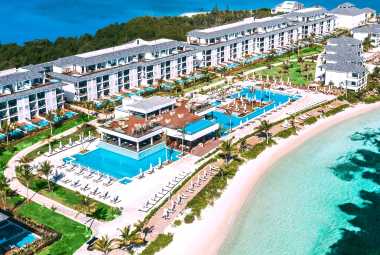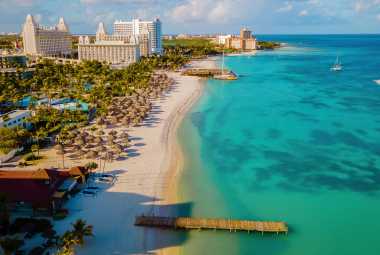Image by jetsetjansen.com
*Vacation Mode is a for-profit site. It contains paid banner advertisements that are generated and managed by a third-party network. This site also includes relevant affiliate links (both in the content and on the sidebar) all of which we do our best to clearly mark as such.
Quick Summary
-
Best Time to Visit the Philippines:
- Ideal during the dry months from November to April for sunny days, cooler nights, and beach activities.
- Off-peak season from May to October offers fewer crowds, lower prices, and is ideal for surfing due to consistent waves.
-
Climate in the Philippines:
- Tropical paradise climate with warm temperatures, high humidity, and varied weather conditions.
- Offers a range for outdoor activities; however, be prepared for typhoons, especially from June to November.
-
Peak Season (December to February):
- Attracts tourists for its vibrant attractions, stunning beaches, and lively festivals.
- Popular destinations include Boracay and Palawan, with a range of accommodations.
- Festivals like Sinulog in Cebu and Ati-Atihan in Aklan showcase cultural performances.
-
Off-Peak Season (June to November):
- Features fewer crowds, better deals on accommodations, and pleasant weather conditions.
- Offers a chance to immerse more deeply in the local culture and enjoy cost-effective travel options.
-
Weather Conditions:
- Peak season has warm and sunny weather with average temperatures ranging from 25 to 32 degrees Celsius.
- Off-peak season experiences higher humidity, occasional typhoons, and increased rainfall.
-
Festivals and Events:
- Peak season: Ati-Atihan Festival in Kalibo, Sinulog Festival in Cebu, and Pahiyas Festival in Lucban.
- Off-peak season still offers vibrant cultural experiences and opportunities to engage with local traditions.
-
Travel Tips:
- Explore diverse landscapes, pack light and suitable clothing, and take health precautions.
- Plan itinerary considering weather, accommodation deals, and cultural events.
-
FAQs:
- Best time to travel: Dry season (November to April) for pleasant weather and lower typhoon risk.
- Weather: Warm and sunny, with temperatures ranging from 25-32°C.
- Festivals: Ati-Atihan in January and Sinulog in February are highlights.
- Costs: Prices may be higher during peak season; booking in advance is recommended.
- Safety: Avoid typhoon-prone areas during peak times and stay updated on weather advisories.
- Activities: Island hopping, snorkeling/diving, exploring cities, and enjoying local cuisine are top activities.
Are you dreaming of a tropical getaway to the stunning islands of the Philippines but unsure of the best time to visit? We will explore the climate in the Philippines, the peak and off-peak seasons, weather conditions, festivals and events, and provide travel tips to help you plan your trip.
Whether you prefer to bask in the sun during peak season or enjoy a quieter vacation during off-peak season, we've got you covered. Let's dive in and discover the ideal time to travel to this beautiful destination!
When is the Best Time to Travel to the Philippines?
Planning your vacation to the beautiful destination of the Philippines involves choosing the best time to travel based on weather, season, and climate conditions.
Visiting the Philippines can be a delightful experience if planned around the weather patterns. The peak season falls during the dry months from November to April, offering sunny days and cooler nights. This period is perfect for beach activities, diving, and exploring the stunning islands.
On the other hand, the off-peak season from May to October sees more rain, yet it also means fewer crowds and lower prices. Travelers keen on adventure sports like surfing may find the off-peak season ideal due to the consistent waves along the coast. Ultimately, whether you prefer bustling activities or a tranquil escape, understanding the seasonal variations in the Philippines is crucial for a memorable trip.
What is the Climate in the Philippines?
The Philippines boasts a tropical paradise climate with warm temperatures, high humidity levels, and a diverse range of weather conditions throughout the year.
This unique climate makes the Philippines a haven for beach enthusiasts seeking sun-drenched shores and crystal-clear waters. The temperature variations, which can range from balmy to scorching hot, offer visitors a chance to indulge in a variety of outdoor activities, from snorkeling and diving to hiking and island hopping.
The high humidity levels, especially during the rainy season, contribute to lush green landscapes and vibrant flora, creating a picturesque backdrop for sightseeing. Travelers should be prepared for occasional typhoons, especially from June to November, which can impact travel plans but also bring dramatic skies and stunning sunsets.
Peak Season in the Philippines

The peak season in the Philippines attracts numerous tourists seeking vibrant attractions, stunning beaches, lively festivals, and diverse accommodation options.
During this bustling period, visitors flock to popular destinations like Boracay, known for its white sandy beaches and vibrant nightlife, or Palawan, home to the stunning Underground River.
The range of accommodation choices caters to every preference, from luxury beachfront resorts to budget-friendly hostels.
Traveling during peak season offers the advantage of experiencing the energy and excitement of festivals like Sinulog in Cebu or Ati-Atihan in Aklan, where cultural performances and street parades captivate audiences from around the world.
What are the Months of Peak Season?
The peak season in the Philippines typically occurs during the months of December to February, attracting a surge of tourists to enjoy the country's top attractions, accommodations, and cultural experiences.
During these months, the Philippines experiences pleasant weather characterized by cooler temperatures and less rainfall, making it an ideal time for exploring the stunning beaches, vibrant festivals, and lush landscapes that the country has to offer.
Popular attractions like Boracay, Palawan, and Cebu see an influx of visitors seeking sun, sand, and sea adventures. From luxurious beachfront resorts to cozy homestays, a wide range of accommodations cater to different preferences and budgets. The ambiance during the peak season is lively and bustling, with colorful street parades, delicious traditional food vendors, and a vibrant nightlife scene adding to the festive atmosphere.
What are the Advantages of Traveling During Peak Season?
Traveling during the peak season in the Philippines offers a plethora of advantages, including vibrant activities, exciting festivals, and unforgettable cultural experiences.
Immersing yourself in the lively atmosphere of the Philippines during the peak season opens up a world of opportunities for travelers seeking both adventure and relaxation.
From exploring the stunning beaches and crystal-clear waters for snorkeling and diving to trekking through lush rainforests and experiencing the rich biodiversity, there is no shortage of exciting activities to indulge in.
The vibrant festivals that take place during this time showcase the colorful culture of the country, offering a chance to witness traditional dances, taste delicious local cuisine, and engage with friendly locals.
To make the most of your trip, consider planning ahead and participating in guided tours to fully immerse yourself in the diverse offerings that the Philippines has to offer.
Off-Peak Season in the Philippines
Exploring the Philippines during the off-peak season offers travelers the opportunity to enjoy fewer crowds, better deals on accommodations, and favorable weather conditions at a lower cost.
With reduced tourist numbers, travelers have the chance to immerse themselves more deeply in the local culture and experience a more authentic side of the destination. The cost-effective accommodations during this period allow budget-conscious travelers to stretch their funds further and potentially splurge on unique experiences or local cuisine. The pleasant weather conditions provide an ideal backdrop for outdoor adventures, from exploring pristine beaches to hiking through lush green mountains, without the discomfort of overcrowding or extreme heat.
What are the Months of Off-Peak Season?
The off-peak season in the Philippines typically spans the months of June to November, offering travelers the chance to explore the country amidst quieter surroundings and cost-effective travel options.
During this period, visitors can revel in the natural beauty of the Philippines without the bustling crowds, making it ideal for those seeking a more serene travel experience. Not only are accommodations more affordable, but attractions and activities are often less crowded, allowing for a more intimate exploration of the stunning landscapes and vibrant culture of the archipelago.
The weather during the off-peak season is often pleasant, with occasional rain showers that add a refreshing touch to the lush greenery. Travelers can also take part in unique experiences such as joining local festivals, diving in pristine waters, or embarking on exciting jungle treks, all while enjoying significant cost savings and a more relaxed atmosphere.
What are the Advantages of Traveling During Off-Peak Season?
Traveling during the off-peak season in the Philippines offers distinct advantages, including serene environments, uncrowded attractions, and opportunities for relaxation and rejuvenation.
Exploring this breathtaking destination during the quieter periods allows travelers to truly immerse themselves in the local culture and savor moments of solitude. With fewer crowds around, one can appreciate the pristine beaches, lush landscapes, and stunning natural wonders without the hustle and bustle of peak tourism.
Whether it's enjoying a leisurely stroll along secluded shorelines, indulging in authentic regional cuisine at hidden gems without the wait, or taking part in peaceful outdoor activities like yoga or meditation amidst scenic backdrops, the off-peak season presents a tranquil escape for those seeking a serene getaway.
Weather Conditions During Peak and Off-Peak Season

Understanding the weather conditions during both peak and off-peak seasons in the Philippines is crucial for planning a delightful vacation, considering factors such as temperature, rainfall, and overall climate.
- During the peak season, which typically falls between November and April, travelers can expect warm and sunny weather with average temperatures ranging from 25 to 32 degrees Celsius. This period is ideal for beach activities and exploring the vibrant cities without heavy rainfall interruptions.
- In contrast, the off-peak season from May to October brings higher levels of humidity, occasional typhoons, and increased rainfall, making it important for visitors to pack waterproof gear and plan indoor activities as well.
What is the Average Temperature During Peak and Off-Peak Season?
The average temperatures during peak and off-peak seasons in the Philippines vary, with peak season experiencing higher temperatures ranging from 28°C to 34°C and off-peak season offering milder weather between 24°C to 30°C.
These temperature ranges play a crucial role in shaping the vacation experiences of travelers in the Philippines. During peak season, the warm temperatures create ideal conditions for beach outings, water activities, and island hopping adventures. In contrast, the lower temperatures in the off-peak season make it a great time for exploring the lush landscapes, hiking in cooler weather, and enjoying cultural attractions without the sweltering heat.
Understanding these climate differences can help travelers plan their itineraries and activities accordingly for a more comfortable and enjoyable trip.
What is the Average Rainfall During Peak and Off-Peak Season?
Rainfall patterns during peak and off-peak seasons in the Philippines differ, with peak season typically experiencing higher levels of rainfall compared to the off-peak season.
This variance in precipitation levels plays a significant role in shaping travel plans and outdoor activities for visitors. During the peak season, when the rain is more intense, travelers may need to adjust their schedules and pack accordingly. Waterproof gear, umbrellas, and quick-drying clothing become essential items in this period.
On the other hand, the off-peak season offers a chance for more spontaneous travel, with lighter showers creating a lush, green landscape to explore. By staying flexible and checking weather forecasts regularly, travelers can make the most of their Philippines adventure regardless of the rainfall patterns.
Festivals and Events During Peak and Off-Peak Season

Immerse yourself in the vibrant cultural tapestry of the Philippines by exploring the diverse festivals and events that take place during both peak and off-peak seasons, offering unique insights into the local customs and traditions.
These festivals serve as a window into the rich heritage of the Filipino people, showcasing their deep-rooted values and traditions that have been passed down through generations.
From the lively Ati-Atihan festival celebrating Santo Niño to the colorful MassKara Festival in Bacolod, each event encapsulates the spirit of the community.
The Sinulog Festival in Cebu, characterized by its dazzling street dances, is a must-visit for those seeking an immersive cultural experience.
To fully enjoy these celebrations, make sure to join in the traditional dances, savor local delicacies, and interact with the welcoming locals who are eager to share their heritage.
What are the Popular Festivals and Events During Peak Season?
The peak season in the Philippines is teeming with a myriad of popular festivals and events that showcase the country's rich cultural heritage, attracting both locals and tourists seeking unforgettable experiences.
- One of the most renowned festivals during this bustling period is the Ati-Atihan Festival in Kalibo, which honors the Santo Niño and features vibrant street dances and elaborate costumes symbolizing the island's tribal roots.
- The Sinulog Festival in Cebu captivates spectators with its grand parade, showcasing the devotion to the child Jesus through music, dance, and joyful processions.
- For those who love gastronomic adventures, Pahiyas Festival in Lucban offers a feast for the senses with houses adorned with colorful decorations made from harvested crops and a food fair serving local delicacies.
What are the Popular Festivals and Events During Off-Peak Season?
Even during the off-peak season, the Philippines hosts a variety of popular festivals and events that showcase the country's cultural diversity and offer engaging experiences for travelers seeking authentic encounters.
These festivals are deeply rooted in local traditions and provide a unique opportunity for travelers to immerse themselves in the rich culture of the Philippines. From the vibrant Ati-Atihan Festival in Aklan to the Pahiyas Festival in Lucban, visitors can witness colorful parades, traditional dances, and taste local cuisine.
Participating in these festivals not only allows travelers to celebrate alongside the locals but also fosters a deeper understanding of the community's customs and way of life. For off-peak season festival enthusiasts, exploring these events offers a chance to experience the true essence of Filipino culture beyond the usual tourist attractions.
Travel Tips for Visiting the Philippines
Embark on a seamless and enriching journey to the Philippines with these essential travel tips that cover everything from planning and preparation to safety guidelines and cultural insights.
- When planning your itinerary, consider exploring the diverse landscapes across the Philippines, ranging from stunning beaches to lush green mountains.
- Be sure to pack light, comfortable clothing suitable for the tropical climate and don’t forget essentials like sunscreen and insect repellent.
- It's advisable to exchange currency at reputable locations to ensure you get a fair rate, and consider using public transportation or ridesharing services for cost-effective and convenient travel within cities.
- Taking necessary health precautions such as staying hydrated and using bottled water can help prevent any travel-related illnesses.
Frequently Asked Questions
What is the best time to travel to the Philippines?
The best time to travel to the Philippines is during the dry season, which runs from November to April. This is when the weather is most pleasant and there is a lower chance of experiencing typhoons and heavy rains.
What is the weather like in the Philippines during the best time to travel?
During the best time to travel to the Philippines, the weather is typically warm and sunny with temperatures ranging from 25-32°C. This makes it perfect for enjoying the country's beaches and outdoor activities.
Are there any festivals or events happening during the best time to travel to the Philippines?
Yes, there are several festivals and events that take place during the best time to travel to the Philippines. Some of the most popular ones include the Ati-Atihan Festival in January and the Sinulog Festival in February.
Is it more expensive to travel to the Philippines during the best time?
Generally, prices for flights and accommodations may be slightly higher during the best time to travel to the Philippines. However, it is still possible to find good deals by booking in advance and being flexible with your travel dates.
Are there any areas of the Philippines that should be avoided during the best time to travel?
While the best time to travel to the Philippines is generally safe, it is recommended to avoid traveling to areas that are prone to typhoons and other natural disasters during this time. It is important to stay informed about weather conditions and follow any advisories.
What are the top activities to do in the Philippines during the best time to travel?
Some of the top activities to do in the Philippines during the best time to travel include island hopping, snorkeling or diving in the crystal-clear waters, exploring the vibrant cities, and trying out the local cuisine. You can also visit historical sites and immerse yourself in the rich culture of the country.


















